The Dominican Republic Kids Corner
Some facts about the Dominican Republic
Capital : Santo Domingo de Guzman
Population : 9,183,984 (July 2006)
Geo. Coordinates : 19 00 N, 70 40 W
Area : 48,442 Km²
Currency : Dominican peso
Independence : February 27, 1844
Government : Democratic Republic
Official Language : Spanish
Official Religion : Roman Catholic
National Bird : “Cigua Palmera”
National Flower : Flor de la Caoba
The Dominican Republic was the first colony founded by Christopher Columbus.
The island was named "La Hispaniola" in colonial times.
The Dominican Republic shares the island with Haiti.
Baseball is the Dominican Republic’s national sport.
Julia Alvarez and Nelly Rosario are famous writers from the Dominican Republic.
Ada Balcácer, Candido Bidó, Prats Ventos, Marianela Jiménez Reyes, Ivan Tovar, Chi Chi Cordero and Jaime Colson are famous painters from the Dominican Republic.
The second city is Santiago de los Caballeros.
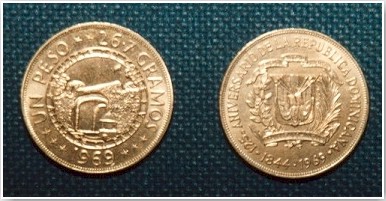
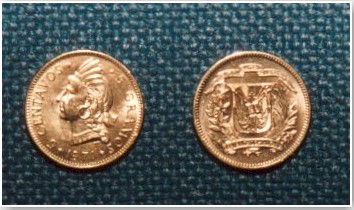
One Peso Coin Former One Cent Coin
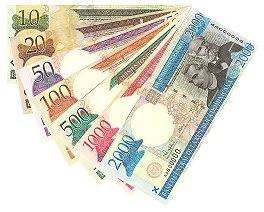
Dominican Pesos Bills
Climate
The majority of the Dominican Republic enjoys beautiful tropical weather all year round, with the average annual temperature hovering around 25°C (77°F). Some call the Dominican Republic's climate, 'the endless summer', due to warm and sunny conditions experienced pretty much everywhere in the country, all year round.
There are slight variations between the summer and winter months. The so-called 'cool' or winter season, runs from November to April. The humidity is relatively low during these months and it tends to cool down in the evenings much more than in the summer months. The coastal/beach regions generally experience highs of around 28°C (83°F) during the day and lows of about 20°C (68°F) in the evening. The mountainous interior of the country is considerably cooler, and on the highest mountain peaks the thermometer can sometimes drop below freezing point. On rare occasions frost can even be seen on the top of these peaks. The summer season in the Dominican Republic runs from May to October. Average daily highs for the coastal/beach regions rise to around 31°C (87°F) during the day, dropping down to about 22°C (72°F) at night. It is the higher humidity during this period that can make it feel much hotter during this season.
Regardless of season, the coolest areas of the country is the Cordillera Central mountain region, around Jarabacoa and Constanza, where the average highs can hover around 16°C (61°F). The desert regions in the southwest of the country experience the highest average temperatures, at times soaring to over 40°C (104°F). The northern areas of the Dominican Republic tend to see the greatest amount of rainfall and do so predominantly between October and April. The southern areas of the Dominican Republic experience their greatest rainfall between May and November.
Torrential downpour-like conditions can certainly occur in all areas of the Dominican Republic but the majority of this type of rainfall occurs in short bursts. Other than major storms that may move through a particular region, most showers are short-lived and have the sun shining brightly within a half hour.
The differences between the summer and winter seasons are not always consistent. Regardless of what is 'typical', the Dominican Republic, like anywhere, can experience abnormal weather patterns - weeks without any rain at all, while other times there are patches of rainy and overcast weather for a several days at a time. But more often than not, visitors to the Dominican Republic can generally expect long periods of sunshine and blue skies, at any time of the year.
Dominican History
Taíno Indians
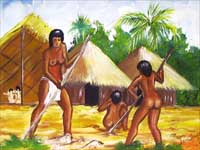
For at least 5,000 years before Christopher Columbus discovered America for the Europeans, the island, which he named Hispaniola , was inhabited by Amer-Indians. Anthropologists have traced multiple waves of indigenous immigration from two principle places. Some of the early Amer-Indians came from Central America (probably Yucatan and/or Belize) and some came from South America, descendants of the Arawakan Indians in Amazonia, many of whom passed through the Orinoco Valley in Venezuela. It is from the blending of these waves of indigenous immigrants that the Taíno Indians , the people who welcomed Columbus on his arrival, are believed to have originated. The word Taíno meant 'good' or 'noble' in their language, which they showed Columbus and his Spanish crew with their peaceful and generous hospitality. Early Spanish chroniclers document they saw no Taíno Indians fighting amongst themselves. By the end of the 15th century, the Taíno were well organized into five political units called cacicazgos and were considered to have been of the verge of civilization and central government. Recent estimates indicate there were probably several million Taíno living on the island at this time. When Columbus crossed the Atlantic with his crew of Spaniards, he made stops on what is now known as the islands of the Bahamas and Cuba before landing on the island he named Hispaniola - the Taíno called it Quisqueya, Haití, or Bohío. But it was Hispaniola that got the Spaniards excited for several reasons. Columbus' journal is full of descriptions indicating how beautiful the island paradise was, including high, forested mountains and large river valleys. He described the Taíno as very peaceful, generous and cooperative with the Europeans, and as a result, the Europeans saw the Taíno as easy targets to conquer. In addition, they saw the Taíno had gold ornaments and jewelry from the deposits of gold found in Hispaniola's rivers. So after a month or so of feasting and exploring the northern coast of Hispaniola, Columbus hurried back to Spain to announce his successful discovery - but he had lost his flagship and had to leave many of his crewmen behind.
Spanish, French and Haitian Conquests
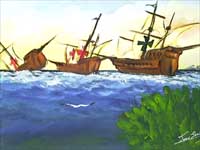
On Christmas Eve 1492, after returning from two days of partying with their Taíno hosts, Columbus' flagship, the Santa Maria , ran afoul on a reef a few miles east of present-day Cap Haitien, after the entire crew had fallen asleep. With the help of the Taíno, they were able to salvage all of the ship's valuables, but the ship itself was lost. Before departing, Columbus was forced to create a small settlement and leave behind a group of 39 of his crewmen. He named this settlement Navidad.
Within a short time after Columbus' departure, the Spanish settlers began fighting amongst themselves, with some even killing one another. They offended the Taíno by forcibly taking their wives or sisters and forcing them to work as their servants. After several months of this abuse, a chief by the name of Caonabó attacked the settlement and killed the Spanish settlers. When Columbus returned to the island with a large expedition the following spring, he was shocked to find the settlement burned to the ground and empty.
The first permanent European settlement, Isabella, was founded in 1493, on the north coast of the island, not far from where Puerto Plata is now. From there the Spaniards could exploit the gold in the Cibao Valley, a short distance away, in the interior of the country. The Spaniards brought horses and dogs, and combined with their armor and iron weapons, as well as their invisible allies, disease germs against which the Taíno had no immunities, the Taíno were unable to resist for long. An expeditionary force was sent to capture Caonabo and another to put down a unified force of thousands of warriors at the site today known as Santo Cerro, after which the Taíno were forced into hard labor, panning for gold under conditions that were repressive and deplorable.
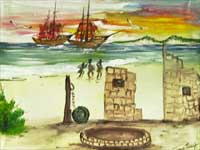
Columbus' brother, Bartholome, was appointed governor while Christopher continued his explorations in the Caribbean region. After the discovery of gold in the south, Bartholomew founded the city of Santo Domingo in 1496. The Spaniards were jealous of the Columbus brothers' (Italian) leadership and so began accusing them of mismanagement when reporting back to Spain. These complaints had them relieved of their positions and both men were brought back to Spain in chains. Once there, it became evident that most of the accusations against them had been grossly exaggerated and Queen Isabella ordered their release.
Their successor as governor of the new colony, Nicolas Ovando, of Spain, decided to take action to "pacify" the Taíno once and for all. He arranged for the widely respected Taíno queen, Anacoana, the widow of Caonabó, to organize a feast, supposedly intended to welcome the new governor to the island. When 80-plus of the island's chiefs were assembled in Anacaona's large wooden caney ('palace') near the site of today's Port au Prince, in Haití, the Spanish soldiers surrounded it and set it on fire. Those who were not killed immediately were brutally tortured to death. After a mock trial, Anacaona was also hanged. Ovando ordered a similar campaign to kill all the Taíno chiefs in the eastern part of the island. With few remaining Taíno leaders, future resistance from the Taíno was virtually eliminated.
Unlike Europeans, Africans, and Asians (who had exchanged diseases for centuries along with commercial goods), the remaining Taíno did not have immunities to the diseases that the Spaniards and their animals carried to the Americas. Forced into brute labor and unable to take time to engage in agricultural activities in order to feed themselves, famine accelerated the death rate. To escape from the Spaniards, some Taíno adopted the tactic of abandoning their villages and burning their crops. They fled to less hospitable regions of the island, forming cimarrón ('runaway') colonies, or fled to other islands and even to the mainland. Smallpox was introduced to the island in 1518 and the Taíno death rate accelerated. After 25 years of Spanish occupation, there were fewer than 50,000 Taíno remaining in the Spanish-dominated parts of the island. Within another generation, the survivors had nearly all become biologically mixed with Spaniards, Africans, or other mixed-blood people--had become the tripartite people today known as Dominicans. Some modern historians have classified the acts of the Spaniards against the Taíno as genocide.
In the first decade of the 1500s, one of the Taíno chiefs, escaped to Cuba, where he became involved in organizing armed resistance to the Spanish invaders. After a brave but uneven struggle, he was captured and tortured to death. The most successful resistance against the Spaniards took place from 1519 to 1534, after the Taíno population had been almost completely decimated. This occurred when several thousand Taíno escaped their captivity and followed their leader Enriquillo to the mountains of Bahoruco, in the south-central part of the country, near the present border with Haiti. It was here, after raiding Spanish plantations and defeating Spanish patrols for 14 years, that the very first truce between an Amer-Indian chief and a European monarch was negotiated. Enriquillo and his followers were all pardoned and given their own town and charter.
By 1515 the Spaniards realized that the gold deposits of Hispaniola were becoming exhausted. Shortly thereafter, Cortez and his small retinue of soldiers made their astonishing conquest of Mexico, with its fabulous riches of silver. Almost overnight the colony, which was usually called Santo Domingo after its capital city, was abandoned and only a few thousand "Spanish" settlers remained behind (many of whom were the offspring of Spanish fathers and Taíno mothers). Columbus' introduction of cattle and pigs to the island had multiplied rapidly, so the remaining inhabitants turned their attention to raising livestock to supply Spanish ships passing by the island en route to the richer colonies on the American mainland. Hispaniola's importance as a colony became increasingly minimized.
By the middle of the 17th century, the island of Tortuga, located to the west of Cap Haitien, had been settled by smugglers, run-away indentured servants, and members of crews of various European ships. In addition to capturing livestock on Hispaniola to sell for their leather, Tortuga became the headquarters for the pirates of the Caribbean, who predominantly raided Spanish treasure ships. This area became the recruiting grounds for expeditions mounted by many notorious pirates, including the famous British pirate Henry Morgan.
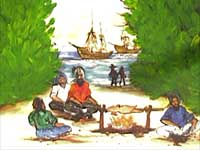
The French, envious of Spain's possessions in the Americas, sent colonists to settle Tortuga and the northwestern coast of Hispaniola, which the Spaniards had totally abandoned by 1603 (under royal mandate, the island's governor, Osorio, forcibly moved all Spaniards to a line south and east of today's San Juan de Maguana). In order to domesticate the pirates, the French supplied them with women who had been taken from prisons, accused of prostitution and thieving. The western third of Hispaniola became a French possession called Saint Domingue in 1697, and over the next century developed into what became, by far, one of the richest colonies in the world. The wealth of the colony derived predominantly from cane sugar. Large plantations were worked by hundreds of thousands of African slaves who were imported to the island.
Inspired by events taking place in France during the French Revolution and by disputes between whites and mulattos in Saint Domingue, a slave revolt broke out in the French colony in 1791, and was eventually led by a French Black man by the name of Toussaint L'ouverture. Since Spain had ceded the Spanish colony of Santo Domingo to France in 1795, in the Treaty of Basilea, Toussaint L'Ouverture and his followers claimed the entire island.
Although L'Ouverture and his successor, Jean-Jacques Dessalines, succeeded in re-establishing order and renewing the economy of Saint Domingue, which had been badly devastated, the new leader in France, Napoleon Bonaparte, could not accept having France's richest colony governed by a Black man. Succumbing to the complaints of former colonists who had lost their plantations in the colony, a large expedition was mounted to conquer the Blacks and re-establish slavery. Led by Napoleon's brother-in-law, General Leclerc, the expedition turned into a disaster. The Black army definitively defeated the French, and the Blacks declared their independence, establishing the Republic of Haiti on the western third of the island of Hispaniola.
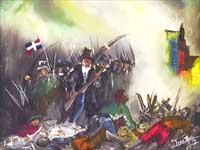
The French retained control of the eastern side of the island, however, and then in 1809 returned this portion to Royal Spanish rule. The Spaniards not only re-established slavery in Santo Domingo, but many of them also mounted raiding expeditions into Haiti to capture Blacks and enslave them as well. Due to the neglect of the Spanish authorities, the colonists of Santo Domingo, under the leadership of José Núñez de Cáceres, proclaimed what came to be called the Ephemeral Independence. In 1822, fearful the French would mount another expedition from Spanish Santo Domingo to re-establish slavery, as they had threatened to do, Haiti's president Jean-Pierre Boyer sent an army that invaded and took over the eastern portion of Hispaniola. Haiti once again abolished slavery and incorporated Santo Domingo into the Republic of Haiti.
Independence
For the next 22 years the whole island of Hispaniola was under Haitian control - Dominicans call the period "The Haitian Occupation". Due to their loss of political and economic control, the the former Spanish ruling class deeply resented the occupation. During the late 1830's, an underground resistance group, La Trinitaria, was organized under the leadership of Juan Pablo Duarte. 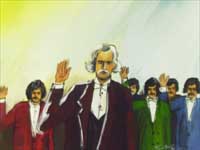 After multiple attacks on the Haitian army, and because of internal discord among the Haitians, the Haitians eventually retreated. Independence of the eastern two-thirds of Hispaniola was officially declared on February 27, 1844, and the name República Dominicana (Dominican Republic) was adopted.
After multiple attacks on the Haitian army, and because of internal discord among the Haitians, the Haitians eventually retreated. Independence of the eastern two-thirds of Hispaniola was officially declared on February 27, 1844, and the name República Dominicana (Dominican Republic) was adopted.
The La Trinitaria leaders of the move for Dominican independence almost immediately encountered political opposition from within, and in six months were ousted from power. From this time on the Dominican Republic was almost constantly under the rule of caudillo, strong leaders who ruled the country as if it were their personal fiefdom. Over the next 70 years, the Dominican Republic had multiple outbreaks of civil war and was characterized by political instability and economic chaos.
For the next quarter of a century the leadership seesawed between that of General Pedro Santana and General Buenaventura Báez, whose armies continuously fought each other for control of government. In an effort to maintain some type of stability, the two military leaders and their armies resorted to outside assistance. In 1861, General Pedro Santana invited the Spanish to return and take over their former colony. But after a short period of mismanagement by Spaniards, the Dominicans realized their mistake and forced the Spaniards out so they could restore the Republic. Another attempt was made for stability when Dominicans invited the United States to take over a decade later. Although U.S. President Grant supported the request, it was defeated by the U.S. Congress and the idea abandoned.
During the 19th century, the country's economy shifted from ranching to other sources of revenue. In the southwestern region, a new industry arose with the cutting down and exporting of precious woods like mahogany, oak and guayacán. In the northern plains and valleys around Santiago, industry focused on growing tobacco for some of the world's best cigars, and on coffee.
In 1882, General Ulises Hereux came into power. His brutal dictatorship consisted of a corrupt regime that maintained power by violent repression of his opponents. General Heureaux handled the country's affairs so poorly that it regularly rocked back and forth between economic crisis and currency devaluations. Following his assassination in 1899, several individuals came to power, only to be rapidly overthrown by their political opponents, and the country's internal situation continuously degenerated into chaos.
Around the turn of the century, the sugar industry was revived, and so many Americans came to the Dominican Republic to buy plantations that they came to dominate this vital sector of the economy. In 1916, Americans, wanting to expand their influence and power in the Dominican Republic, used the First World War as an excuse to bring in U.S. Marines to 'protect it' against vulnerability to large European powers such as Germany. They had used this argument just prior to send in U.S. Marines to occupy Haiti.
The U.S. occupation of the Dominican Republic lasted 8 years, and from the very beginning the Americans quickly took over complete control. They ordered the disbanding of the Dominican Army and forced the population to disarm. A puppet government was installed and obliged to obey orders from the occupying U.S. Marine commanders. A re-modeling of the legal structure took place in order to benefit American investors, allowing them to take control of greater sectors of the economy and remove Customs and import barriers for any American products being brought into the Dominican Republic. Although many Dominican businessmen experienced losses due to these changes, the political violence was eliminated and many improvements in the Dominican Republic's infrastructure and educational system were introduced.
Trujillo, The Dictator
One of the changes the Americans made was to establish and train an Army, which had previously been done in next-door Haiti. Their reasoning was that an internally trained Army would maintain law, order, and public security. In both the Dominican Republic and Haiti, the end result was to shift power away from civilians to the military. During the time of the American occupation, the head of the Dominican Army was a former telegraph clerk by the name of Rafael Leonidas Trujillo. This unscrupulous strongman utilized his position in power to amass an enormous personal fortune from embezzlement activities, initially involving the procurement of military supplies. Although the Dominican Republic had its first relatively free elections after U.S. forces left in 1924, within a short time Trujillo was able to block any government reform actions, and in 1930 he took complete control of power.
Using the Army as his enforcer, Trujillo wasted no time in setting up a repressive dictatorship and organized a vast network of spies to eliminate any potential opponents. His henchmen did not hesitate to use intimidation, torture, or assassination of political foes to terrify and oppress the population to ensure his rule and amass his fortune. Before long he consolidated his power to such a degree that he began to treat the Dominican Republic as his own personal kingdom. He was so arrogant and confident that, after just 6 years at the head of government, Trujillo changed the name of the capital city from Santo Domingo (which name had existed for over 400 years), to Cuidad Trujillo (Trujillo City).
Trujillo received American support of his leadership because he offered generous and favorable conditions to American businessmen wanting to invest in the Dominican Republic. More importantly to the U.S., after World War II, Trujillo showed his political support of the U.S.A.'s stand against the evils of Communism. By 1942 Trujillo even arranged to repay all of the foreign debt due to the U.S., which had for decades limited economic initiatives of the Dominican government. But after several years of confiscating ownership of the majority of the most important domestic businesses, he began to take control of major American-owned industries too, in particular, the very important sugar industry. These take-over activities, combined with Trujillo's meddling in the internal affairs of neighboring countries, led to increasing U.S. disenchantment with the Dominican Republic's dictator.
One of Trujillo's most notorious acts was committed against the Dominican Republic's neighbor, Haiti. For centuries there had been a lack of clear definition of the location of the border between the two countries--a source of aggravation and conflict for both. Not only had the border areas been an area of incessant smuggling activities, but also thousands of Haitians had begun to settle the lands around the ambiguous border. Trujillo had never hidden his racist ideas about the "inferiority and unattractiveness" of the black-skinned Haitians, so in 1937, after first negotiating an internationally lauded border agreement with Haiti's president, he ordered his Army to oversee the massacre of all Haitians on the Dominican side of the border. It is estimated that as many as 17,000 unarmed men, women and children, many of whom had lived in the Dominican Republic for generations, were slaughtered in a bloodbath of violence. Most of this massacre took place around the border town of Dajabón and the aptly re-named Massacre River.
In an attempt to deflect international criticism of this horrendous massacre, Trujillo offered to accept into the Dominican Republic as many as 100,000 Jewish refugees from Nazi Germany. But when it came to action, approximately 600 Jewish families were offered refuge in 1942, settling in what is known today as the El Batey section of Sosua (about 20 kms east of Puerto Plata). Of these families, only a dozen or so remained permanently in the area.
Trujillo remained in power for more than 30 years, but toward the end of his reign he succeeded in alienating even his most avid former supporters, including the U.S. The final straw came when he was linked with an abortive assassination attempt against Venezuelan President Rómulo Bétancourt. A year later, on May 30, 1961, Trujillo's personal automobile was ambushed upon returning from a rendezvous with his mistress, and the dictator and his chauffeur met a violent end. When he died, he was one of the richest men in the world, having amassed a personal fortune estimated to be in excess of $500 million U.S. dollars, including ownership of most of the large industries in the country and a major sector of productive agricultural land. The anniversary date of his assassination, May 30th, is celebrated as a national holiday in the Dominican Republic.
Modern History
After Trujillo's assassination, his vice-president at the time, Dr. Joaquín Balaguer, took control of the presidency. A year and a half later, Juan Bosch, of the Dominican Revolutionary Party (PRD), was elected president. Bosch's socialist program was judged to be too extreme by the U.S., who were then paranoid about the possible spread of Communism after Fidel Castro's successful revolution in Cuba, and because the Dominican Army had maintained Trujillo in power for so many years. The Army's proponents maneuvered to block every one of Bosch's legislative reforms, and only 9 months later they engineered a coup d'état to oust him from the presidency.
The following two years saw political and economic chaos in the Dominican Republic. This culminated when the working classes, allied with a dissident Army faction, rose in rebellion and took action to re-establish constitutional order on April 24, 1965. U.S. President Lyndon Johnson ordered the U.S. Marines to occupy the Dominican Republic under the pretext that Communists were responsible for the political uprising.
A year later, former leader Dr. Joaquín Balaguer was elected president once again, with U.S. help, in what was acknowledged by all observers to have been a rigged election. Balaguer remained in power for the next 12 years, winning re-election in both 1970 and 1974. In both instances the opposition parties maintained that the elections would again be rigged, so they did not even nominate candidates to participate in the electoral races.
In the elections of 1978, the Dominican citizens showed their desire for change by electing Dr. Antonio Guzmán of the Dominican Revolutionary Party (PRD). Balaguer and his supporters had become aware of the pro-PRD movement during the campaign and election, and unwilling to cede defeat, attempted to put an end to the vote counting in order to maintain Balaguer in the presidency. But under international pressure, particularly President Jimmy Carter's government in the U.S., Balaguer was forced to admit defeat and step down.
Just before Guzmán's 4-year term ended in 1982 when he died. In the same year (1982) Dr. Salvador Jorge Blanco, of the same political party, was elected president. Jorge Blanco continued in the time-honored Dominican Republic tradition of rewarding family members, close friends and political supporters with lucrative governmental posts. His term in the Dominican Republic Presidency was, in the end, marred by allegations of massive corruption and misappropriation of government funds. He was later found guilty of both and convicted to 20 years in prison.
Thoroughly disillusioned by the mismanagement and corruption of the leaders of the Dominican Revolutionary Party (PRD), Dominicans returned to the polls in 1986 to opt again for Dr. Joaquín Balaguer. Due to divided and disorganized opposition parties at the next elections in 1990, Balaguer was once again re-elected. With all of his years as President of the Dominican Republic, he had become almost as dictatorial as Trujillo.
During this period, the international community condemned the Dominican government for their continued exploitation of Haitian braceros (sugar cane workers). It has been alleged that thousands of these workers were forced to do backbreaking work for long hours under the hot sun, under the supervision of armed guards. International observers reported that laborers were forced to survive in deplorable living conditions. They were paid only pennies for their toil and were not permitted to leave their places of employment, conditions that have been likened to slavery. In June 1991, bowing to international pressure, all of the Haitian workers were deported. It is suspected that some of these working and living conditions continue to exist for Haitians in the Dominican Republic today--thousands of Haitians work in mainly heavy manual labor and low-paying jobs in the construction and agricultural industries within the Dominican Republic, jobs scorned by the bulk of Dominican citizens. Given the chaotic state of Haiti, it is understandable that anything offered in the Dominican Republic is more than welcomed in terms of work and living conditions, for something is better than nothing.
In 1994, at 88 years of age, Balaguer once again declared victory in an election that the O.A.S. and other international observers unanimously agreed had been rigged. Thousands of names of supporters of his main opponent, Jose Francisco Peña Gomez, of the Dominican Revolutionary Party (PRD), had been removed from the voting. In an effort to avoid a major outbreak of violence, Balaguer and Peña Gomez met and negotiated an agreement whereby Balaguer promised to remain in power no longer than 2 years and not to run for re-election after that. Run-off elections scheduled for May 1996 had early returns showing Peña Gomez holding a plurality. On July 2, 1996, Dr. Leonel Fernández and his Dominican Liberation Party (PLD) edged out Gomez with a 51% of the vote.
Leonel Fernandez
Part of Leonel Fernandez's reforms depended on his party gaining a majority in the elections for the National Assembly in May 1998. A few weeks before the elections were held, Peña Gomez died of cancer. The Dominican Republic declared a two-day mourning period to honor the politician.
In 2000, Fernández was voted out of office in remarkably free and fair elections. Although the country was enjoying its greatest economic growth and success in its history, voters chose Hipólito Mejía of the Dominican Revolutionary Party (PRD. The election gave Hipólito and his party control of the executive branch, a majority in the upper house legislature, and near control of the lower house.
Up until 2001, tourism and manufacturing sustained the Dominican Republic's economy with an impressive seven percent average annual growth. Added to the expansion in these sectors, the Dominican Republic received substantive remittances from Dominicans living outside the country, the majority of whom were now living and working abroad.
The following two years saw the hopeful signs exhibited early in Hipólito's administration give way to political scandal as well as a global recession. In 2003, the Dominican Republic's third largest private financial institution, Banco Internacional (Baninter ), went into bankruptcy, due to enormous fraud engineered by the bank's owners and administrators. Shortly thereafter, two other major Dominican banks also declared bankruptcy. The impact on the Dominican economy was devastating. By January 2004, a mere seven months after Banco Internacional's collapse, the peso's exchange rate had fallen to 50 to U.S. $1 (down from 16 to U.S. $1 in 2002). To make the economic situation even worse, for a time the IMF (International Monetary Fund) suspended their loans to the Dominican Republic, citing Hipólito's purchase of two private energy facilities (which were once owned by the Dominican Republic and sold to private holders by Fernández during his administration) and spending on public programs they believed were used solely to boost Hipólito's reputation with the country's poor. The loans were eventually dispersed but not before the peso's exchange rate went down even further against the U.S. dollar.
During Hipólito's time in office, he orchestrated a constitutional amendment allowing consequential presidencies (which was previously prohibited), although he vowed publically over and over that he would not run again in 2004 - but he did. In May 2004, the country's citizens, desperate for a return to prosperity, and despite having accused his previous administration of corruption and fraud, voted in Dr. Leonel Fernández and his Dominican Liberation Party (PLD) again. It remains to be seen whether Dr. Leonel Fernández and the PLD can make the changes necessary to bring the economy under control, while at the same time making the citizens of the Dominican Republic happy. They are entering government with a national debt of $7.6 billion, which is an enormous sum for such a small country. The Dominican Republic has secured $2.2 billion in loans from various sources to stabilize its finances and help bring about change. The people of the Dominican Republic are hoping the economic growth and success their country saw in the 1990's will make a comeback and that the peso will once again stabilize to a reasonable exchange.
In recent years, the Dominican Republic has evolved into a reasonably free and Democratic nation. Political demonstrations take place openly and freely in the streets, and politicians are able to campaign without being censored. Average Dominican people are involved in the political arena and the country's newspapers provide a free and open flow of information for its citizens. Even with these advancements, the country is still watched over by the National Police and Army, who tend to act in the interests of the politicians holding power. This, along with continual problems with corruption, need to be overcome before the Dominican Republic can call itself a true and developed democracy.
The Music in the Dominican Republic
Merengue
Merengue is a type of lively, joyful music and dance that comes from the Dominican Republic. Merengue means whipped egg whites and sugar in Spanish, similar to the English word meringue. It is unclear as to why this name became the name of the music of the Dominican Republic. This style of music was created by Ñico Lora in the 1920s; however, it was promoted by Rafael Trujillo, the president in the 1930s, and eventually became the country’s national music and dance style. World famous Merengue singers include Miriam Cruz & Las Chicas Del Can, Juan Luis Guerra, Wilfrido Vargas, Sergio Vargas, Johnny Ventura, Kinito Mendez, Ravel, Josie Esteban y la Patrulla 15, Pochy y su Cocoband, Fernando Villalona, Cuco Valoy, The Freddie Kenton Orquestra, Elvis Crespo and Conjunto Quisqueya. Other artists popular in the Dominican Republic as of 2006 include Julian, Toño Rosario, Aguakate and Amarfis. Milly Quezada is known as the Queen of Merengue.
Typical instruments
Bass guitar, Diatonic accordion, Guira, Guitar, Saxophone, Trumpet, Tambor
Guira 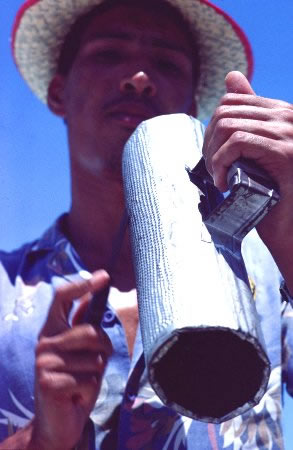 Tambora
Tambora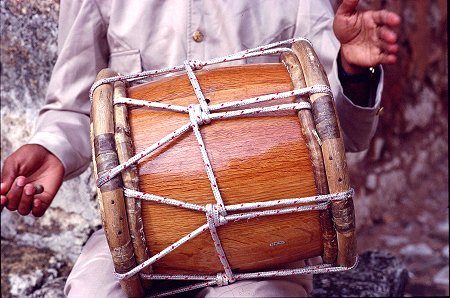
By far the most influential of the music and dance styles of the Dominican Republic has been the merengue. Performed as a pulsating two-step, the percussive scraping of the guira is an essential ingredient in maintaining the forward motion generated by merengue bands and required by the dancers. The problem with native guiras, favored by purist merengue artists, is the inconsistent playing surface and fragile scrapers. The new LP Professional Merengue Guira addresses these sonic and durability issues, putting the authentic, rasping scrape back in the Dominican dance form. Designed with input by professional merengue artists, the body of the LP Professional Merengue Guira is constructed of durable, stainless steel that will replicate the same tones after repeated scraping. The texture of the ridged surface plays like a native instrument, and the scraper is designed to feel traditional. Both are key components in player comfort v and in producing the correct raspy tone and bright overtones that cut through ensembles, even when the dance hall is jumping. Players will appreciate the inclusion of a metal handle that makes the instrument easy to hold when bearing down on challenging rhythms.
Some Dominican famouse musicians are Juan Luis Guerra, Manuel Tejada, Juan de Dios Ventura Soriano, Maridalia Hernández, Milly Quezada, among others.
Dominican Food
Dominicans enjoy an array of foods as colorful as the landscape, but simple in taste. Women especially take pride in preparing exciting traditional dishes, layered with ingredients of the land. Inspiration for Dominican cuisine stems from native Antillean and hearty Creole recipes and is prepared similar to the dishes of Central and South America with rice, fish and other seafoods, meats or vegetables. Light spices or coconut add depth and warm the soul. Culinary specialties of the country vary from region to region, although residents of the Dominican Republic share a common hunger for its staple meals.
GREEN PLANTAIN PUREE or "MANGU" 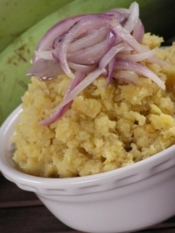
A Dominican favorite usually eaten for breakfast or dinner is “Mangú” a mix of plantains, cheese and bacon. This is a very filling dish, a real "stick-to-the-ribs" item, historically fed to the field workers before they went out for a long day of hard cane-cutting. Mangú has been dubbed the "mashed potatoes" of the Dominican Republic and is a must-try.
"Mangu" Recipe
Ingredients for 6 servings
3 large green plantains
2 oz. olive oil
6 oz. sliced onion (white)
6 oz sliced Cuban or Anaheim peppers
1/4 quart of the plantain boiling liquid
1.5 oz. salt
Preparation
Wash the plantains very well and then boil for about 20 minutes. Time will depend on age of the plantain and it's size. Remember that you will be preparing a puree so make sure the plantains are fully but not overly cooked.
Let cool a bit then remove the skins and in a bowl and the salt and then mash with the indicated amount of boiling liquid.
Transfer to a food processor or strong blender and finish the pureeing.
Sautee the onions in the olive oil.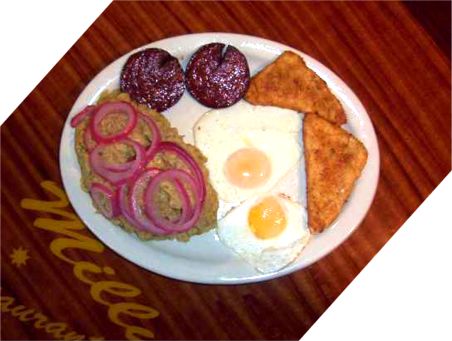
Shown in this picture mangu with onion on top, two fried eggs, fried cheese and salami. Typical Dominican Breakfast.
A foundation of the native diet, "La Bandera Dominicana", or the Dominican flag meal, is eaten by 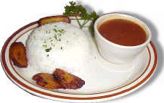 nearly everyone at lunch time. The most important meal of the day, "La Bandera" consists of rice, beans, meat, vegetables and fried plantains to ensure energy throughout the afternoon and evening.
nearly everyone at lunch time. The most important meal of the day, "La Bandera" consists of rice, beans, meat, vegetables and fried plantains to ensure energy throughout the afternoon and evening.
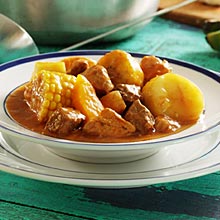
Another popular dish is "Sancocho," a Spanish-style stew usually served with rice. Ingredients include various roots, green plantains, avocado and typically chicken or beef and 7 meat.
"Locrio," or Dominican rice, varies with its preparer. An adaptation of the Spanish paella, locrio is made with achiote (a colored dye produced from the seeds of the achiote plant), since saffron spice is unavailable.
Near Samaná, coconut trees decorate the landscape and provide a delectable milk sauce for fish, known as "Pescado con Coco." Throughout the south central coast, "bulgur", or whole wheat, is a main ingredient in "Quipes" (ground beef wrapped in wheat) or "Tipili" (bulgur salad).
Other favorite Dominican dishes include:
"Chicharrones de pollo" (diced chunks of deep fried chicken)
"Yucca cassava" (type of bread)
“Tostones” plantain
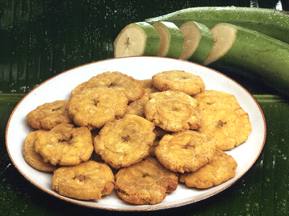
"Monfongo" (plantain and pork meat based dish)
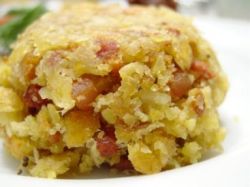
"Ropa vieja" (seasoned and fried shredded beef served with rice and a side salad).
"Pastelitos"(meat-or -cheese filled pastry turnovers).
Desserts
A proper Dominican meal is not complete without dessert. In a land abundant with sugar cane, most desserts are exceptionally sweet. Cakes, puddings, caramel-dipped fruits and creams are common.
"Arroz con leche" (rice pudding)
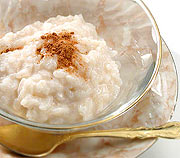
"Mango cake"
"Flan"
"Dulce de leche" (milk cream flavored with coconut or fruit)
"Dulce de coco" (thick, sweet coconut paste)
"Bizcochos" (cakes with white cream topping)
"Frío fríos" (shaved ice with fruit syrups)
"Agua de coco" (sliced coconuts mixed with sugar cane juice and native fruits of the island such as mangoes, pineapples, oranges, bananas and plantains)
For more information on food and recipes log on to:
www.dominicancooking.com
www.godominicanrepublic.com
www.thedominicanrepubic.net
Presentation Domincan Republic Kids Corner:
Dominican Republic History(pdf)
